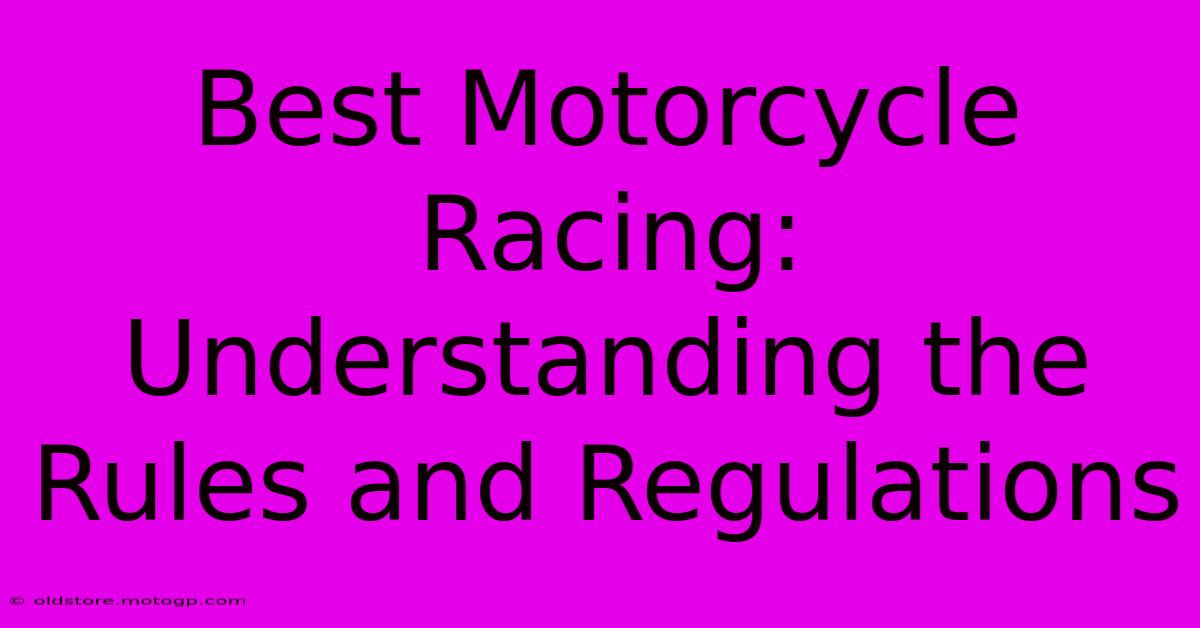Best Motorcycle Racing: Understanding The Rules And Regulations

Table of Contents
Best Motorcycle Racing: Understanding the Rules and Regulations
Motorcycle racing, a thrilling spectacle of speed, skill, and precision, captivates millions worldwide. But beyond the roar of the engines and the blur of motion lies a complex framework of rules and regulations ensuring fair competition and rider safety. Understanding these rules is crucial for both aspiring racers and enthusiastic fans alike. This comprehensive guide delves into the key aspects governing various motorcycle racing disciplines.
The Governing Bodies: Setting the Standards
Different racing organizations govern various motorcycle racing classes. The most prominent include:
-
FIM (Fédération Internationale de Motocyclisme): The international governing body for motorcycle sport, setting standards for worldwide competitions, including MotoGP, Moto2, and Moto3. Their regulations cover everything from technical specifications to rider conduct.
-
AMA (American Motorcyclist Association): The governing body for motorcycle racing in the United States, responsible for setting rules and organizing national championships across various disciplines.
-
MSMA (Motorcycle Sports Manufacturers Association): This association represents the interests of motorcycle manufacturers involved in Grand Prix racing, contributing significantly to the technical regulations.
Key Aspects of Motorcycle Racing Regulations:
1. Technical Regulations: The Machine Matters
Technical regulations are incredibly detailed, specifying allowable engine capacity, dimensions, weight, materials, and safety features for each racing class. These rules aim to:
- Promote fair competition: Preventing teams with superior resources from dominating through technological advantage.
- Enhance rider safety: Mandating safety equipment and design features to minimize injury risks.
- Control costs: Setting limits on technology to make racing more accessible.
Examples of Technical Specifications:
- Engine size and type: Different classes have specific engine size restrictions (e.g., MotoGP's high-capacity engines vs. Moto3's smaller ones). Engine configurations (e.g., four-stroke vs. two-stroke) are also often regulated.
- Aerodynamics: Rules often govern aerodynamic aids like fairings and winglets to ensure safety and prevent excessive speed increases.
- Chassis and safety components: Strict guidelines cover frame materials, suspension systems, brakes, and rider safety equipment like helmets, suits, and boots.
2. Sporting Regulations: Fair Play on the Track
Sporting regulations cover aspects beyond the machine, focusing on rider conduct and race procedures:
- Race starts: Precise procedures dictate how races begin, including grid positions and starting lights.
- Overtaking: Regulations specify rules for overtaking maneuvers, aiming to prevent unsafe and unfair overtaking tactics.
- Penalties: Penalties are imposed for infractions, ranging from warnings to disqualification, depending on the severity of the violation. These penalties might include track limits infractions, unsafe riding, or unsportsmanlike conduct.
- Flags and signals: Racers must understand the meaning of various flags and signals used by race officials to communicate important information.
- Rider conduct: Rules address aspects of sportsmanlike conduct, prohibiting actions like dangerous riding or physical contact with other riders.
3. Safety Regulations: Protecting Riders
Rider safety is paramount. Regulations mandate the use of specific safety equipment and impose strict penalties for breaches of safety procedures:
- Mandatory safety equipment: High-quality helmets, racing suits, gloves, and boots are compulsory, designed to minimize the risk of serious injuries.
- Track safety features: Circuit design and safety features like runoff areas and barriers play a crucial role in mitigating accidents.
- Medical support: Comprehensive medical support is a critical aspect of every racing event, including ambulance services and medical personnel on-site.
Understanding the Nuances Across Disciplines
While the general principles remain consistent, specific regulations vary depending on the racing discipline. MotoGP, Moto2, Moto3, Superbike, and other classes have their own unique rules and regulations tailored to their technical characteristics and competitive format.
Conclusion: More Than Just Speed
Motorcycle racing is a highly regulated sport. The combination of technical, sporting, and safety regulations creates a framework for fair, exciting, and (relatively) safe competition. Whether you are a racer, team member, or spectator, understanding these rules is essential for appreciating the full complexity and thrill of this exhilarating sport. Staying updated on the latest rule changes is crucial to keep abreast of the evolving landscape of motorcycle racing.

Thank you for visiting our website wich cover about Best Motorcycle Racing: Understanding The Rules And Regulations. We hope the information provided has been useful to you. Feel free to contact us if you have any questions or need further assistance. See you next time and dont miss to bookmark.
Featured Posts
-
Moto Gp Aero The Technological Arms Race
Feb 19, 2025
-
Moto Gp Starting Grid The Key To Winning The Championship
Feb 19, 2025
-
Cota Parking Map Maximize Your Race Day Experience
Feb 19, 2025
-
Motorcycle Racing Understanding The Various Categories
Feb 19, 2025
-
Moto Gp Austin 2025 Witness The Showdown
Feb 19, 2025
